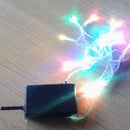Introduction: Homemade RCA Attenuator
This project arose from the fact that I had too much gain in my audio system, and I needed a practical solution without modifying the PCB circuit.
The problem can be solved using an RCA (in-line) attenuator, but since a new one can be quite expensive, around 30-40 € or even more, so I decided to make one by myself.
Step 1: Preliminary Informations
There are very simple gadgets that can be used for audio purposes with great results. These are passive attenuators. They are very simple objects based on a resistive partition housed in male-female RCA connectors and can be used in particular when there are differences in sensivity between the source (CD player, preamp, etc.) and the amplifier.
Despite the simple construction scheme, as I said before they can be quite expensive in the market.
_____________________________________________________
Before proceeding further, we have to remember that the audio signal can be distinguished substantially in two categories:
.
1) balanced circuit
2) unbalanced circuit
.
The main difference between the two is that one is represented by an unshielded cable while the other does not. However, in reality the common RCA cable we use every day is made up of two conductors, one positive and one negative that also performs the shielding function against interferences (provided that is not too long).
So, that to whom we will be paying attention is the latter (SEE IMAGES).
Step 2: Part List and Tools
The following components can be purchased at any electronics store or via Ebay:
.
-2 Solder RCA Female Connectors (1 black + 1 red)
-2 Solder RCA Male Connectors (1 black + 1 red)
- 4 Metal film resistors (1/4 Watt): one couple of 6.9 KOhm, the other couple of 4.7 KOhm
- Aluminium tube
- Insulating tape
- Heat-shrink tubing
- Electric wire
- Cyanoacrylic glue
.
Tools to be used for operations: scissors, tin welder, tin wire,metal saw.
Step 3: Calculating the Resistors
First of all, I'm going to show the formulas relating a typical unbalanced circuit; in other words I'm speaking of the L (or L-pad) attenuator formula (SEE IMAGE).
This will help us to choose the correct value of the two resistors.
There are many on-line calculators, so the the task can be facilitated.
For my purposes, since I wanted a 10 dB attenuation, via the on-line calculator I found the following resistance values (relative to an input impedance of 10 KΩ):
.
Ra = 6838 Ω (nearest commercial value = 6.9 KΩ)
Rb = 4625 Ω (nearest commercial value = 4.7 KΩ)
.
Step 4: How to Build: Part 1)
The outer casing consists of two pieces of an aluminum tube that can be purchased in any hardware store.
I bought one one meter long tube and with a diameter just slightly greather than the RCA internal screw. Then I cut two equal pieces of 4-5 cm long each.
It is important that the piece is not too short to ensure that the male/female connectors are not close to each other and that there is enough space for the two resistors. Then two wires (2-3 cm in length) are connected between the resistors and the terminals of the RCA connector.
The two pieces can then also be painted at will (as I did, by means of spray paint) or left to its natural aluminium color.
Step 5: How to Build: Part 2)
After unscrewing the male / female RCA connectors, the two resistors, respectively 6.9 KOhm and 4.7 KOhm, are soldered on. The first to the signal pin while the second in parallel from signal to ground pin.
You can choose the female connector for this operation, but the reverse is also fine. It is advisable to cover bare wires and resistors with shrink tubing and insulating tape.
After this operation, the two resistors are interwoven and slightly soldered each other. Furthermore, at the end of the ground pin there is a bit of resistance wire (SEE IMAGES).
At the end of the previous resistors, two electric wires (2-3 cm long) will be soldered and will then be connected to the ends of the other connector.
At this point, the screw of each RCA connector is wound with the insulating tape so that it can fit perfectly inside the aluminum tube. A little of cyanoacrylic glue guarantees the seal of the connector to the tube.
Once the operation is done on one, the next one will be to solder the wires to the terminals of the other connector. Finally, the second screw of the connector is fastened to the tube, always with the help of a little glue.
The end result is the one in the last picture.




